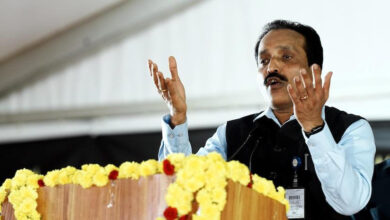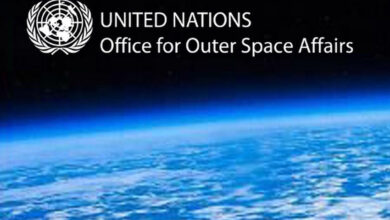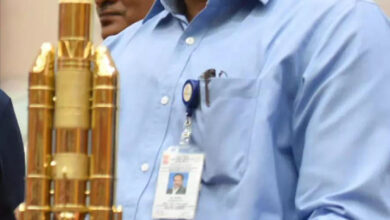India Launches Seventh Navigation Satellite IRNSS-1G
 Sriharikota/ New Delhi. India successfully launched navigation satellite IRNSS-1G from Satish Dhawan Space Centre SHAR Sriharikota April 28.
Sriharikota/ New Delhi. India successfully launched navigation satellite IRNSS-1G from Satish Dhawan Space Centre SHAR Sriharikota April 28.
The 1425 kg Indian Regional Navigation Satellite System IRNSS-1G was put into the elliptical orbit by Indian Space Research Organisation’s in its thirty fifth flight PSLV-C33. This is the thirty fourth consecutively successful mission of PSLV and the thirteenth in its ‘XL’ configuration.
After PSLV-C33 lift-off at 1250 hrs (12:50 pm) IST from the First Launch Pad with the ignition of the first stage, the subsequent important flight events, namely, strap-on ignitions and separations, first stage separation, second stage ignition, heat-shield separation, second stage separation, third stage ignition and separation, fourth stage ignition and satellite injection took place as planned. After a flight of 19 minutes 42 seconds, IRNSS-1G was injected into an elliptical orbit of 283 km X 20,718 km inclined at an angle of 17.867 degree to the equator (very close to the intended orbit) following which the satellite successfully separated from the PSLV fourth stage.
After separation, the solar panels of IRNSS-1G were deployed automatically. ISRO’s Master Control Facility (MCF) at Hassan, Karnataka took over the control of the satellite. In the coming days, four orbit manoeuvres will be conducted from MCF to position the satellite in the Geostationary Orbit at 129.5 deg East longitude.
Prime Minister Narendra Modi heartily thanked and congratulated all the ISRO scientists and team ISRO for completing IRNSS constellation and dedicated IRNSS to the nation as ‘NavIC’ (Navigation Indian Constellation). He appreciated India’s space community for making the country proud through such achievements which have helped in improving the life of common man.
President Pranab Mukherjee and Vice President Hamid Ansari congratulated the ISRO on the successful launch of PSLV-C33 carrying IRNSS-1G, India’s seventh and final in the series of navigation satellites of the Indian Regional Navigation Satellite System (IRNSS).
In a message to ISRO Chairman AS Kiran Kumar, the President said, “I extend my hearty congratulations to you and your entire team at the ISRO on the successful launch of PSLV-C33 carrying IRNSS-1G, the seventh and final in the series of navigation satellites of the Indian Regional Navigation Satellite System (IRNSS).
The launch of PSLV-C33 is an important landmark in our space programme with India now joining the small group of nations having their own regional satellite navigation system. It demonstrates, yet again, India’s growing capabilities in space launch technology. The nation is proud of this achievement.
Kindly convey my greetings to all members of your team and all others involved in this great mission. I wish the ISRO continued success in its future endeavours.â€
IRNSS-1G is seventh and the final of the seven satellites constituting the space segment of the Indian Regional Navigation Satellite System. IRNSS-1A, 1B, 1C, ID, IE and 1F, the first six satellites of the constellation, were successfully launched by PSLV on July 2, 2013; April 4, 2014; October 16, 2014; March 28, 2015; January 20, 2016 and March 10, 2016 respectively. All the six satellites are functioning satisfactorily from their designated orbital positions.
IRNSS is an independent regional navigation satellite system designed to provide position information in the Indian region and 1500 km around the Indian mainland. IRNSS provides two types of services, namely, Standard Positioning Services (SPS) provided to all users and Restricted Services (RS) provided to authorised users.
A number of ground facilities responsible for satellite ranging and monitoring, generation and transmission of navigation parameters, etc, have been established in 18 locations across the country. Today’s successful launch of IRNSS-1G, the seventh and final member of IRNSS constellation, signifies the completion of the IRNSS constellation.





